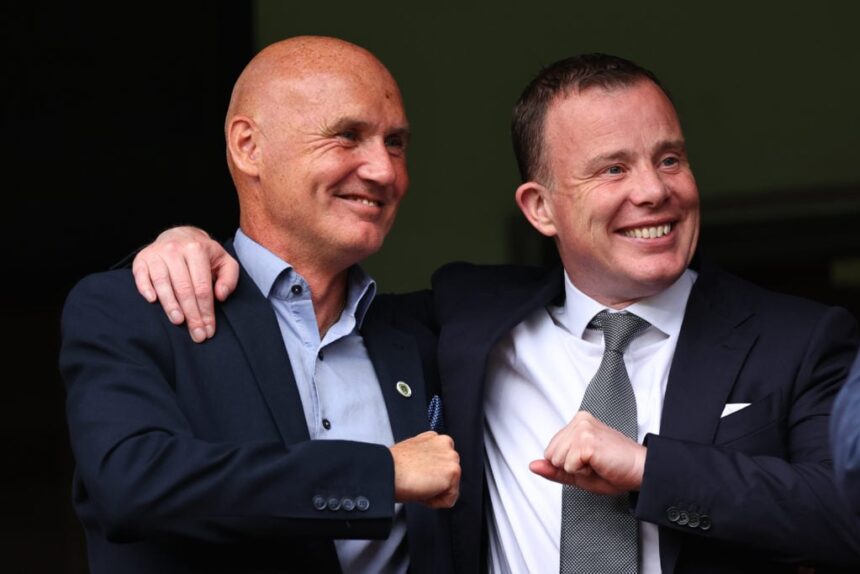In the last few emotional months as the sun set on Goodison Park, Dan Friedkin has got a measure of what it means to be an Everton fan. Part of new CEO Angus Kinnear’s job is to carry that identity and emotion into Bramley Moore Dock, without being trapped by it.
The final game at Goodison Park – for the men’s team, at least – against Southampton on Sunday will be a day of nostalgia, with a chaser of dreaming about what is to come for Everton in their new home on the banks of the Mersey.
Following his arrival from Leeds United, Angus Kinnear will be tasked with modernising a club which, relative to its status as one of the grandest teams in English football, has consistently underachieved in the Premier League era.
There is no good reason why Everton shouldn’t be one of the country’s most successful clubs. The so-called ‘Big Six’ have a monumental financial advantage, true, but the gap is shrinking.
In recent seasons, Newcastle United, Aston Villa, Nottingham Forest, Bournemouth, Brighton, Brentford and the like have proven that it is possible to defy the gravity of Profit and Sustainability Rules (PSR) and unsettle the Big Six oligopoly.
Under Dan Friedkin, Everton have a new owner who has the commercial know-how to get the club ticking financially and build a platform to compete at the top end of the table. Bramley Moore Dock, of course, is the base ingredient in the special sauce that the American investor is mixing.
While it will probably always be Everton’s spiritual home, Goodison Park has limited the club financially.
The club generated £19m in matchday income in the last financial year – that’s bottom half of the table in Premier League terms and, over the course of the season, less than £1m per match.
Contrast that to Tottenham, who earn around £6m per match on top of £60m per season from non-football events.
Credit: Adam Williams/TBR Football/GRV Media
Even at the less elite end, the contrast is stark. Per seat at Goodison, Everton earn about £480 per year. At Fulham, it’s £608. Stack those figures up over the course of a season and the missed revenue is clear.
The buck will stop with Angus Kinnear, however, when it comes to balancing the commercialisation of Bramley Moore Dock with the interests of bedrock fans.
And one element of his strategy is now clear.
Everton officially advertising for Bramley Moore Dock chief
Former owner Farhad Moshiri expects Everton to earn £43.7m in annual matchday income at Bramley Moore Dock, but the financial benefits will extend beyond what comes in through the turnstiles.
The move away from Goodison is expected to yield an eight-figure naming rights deal, while a shiny new stadium will also give the club greater leverage with sponsors.
Everton’s front-of-shirt sponsorship is up for sale following the withdrawal of Stake.com, meaning Kinnear and his team have the chance to tie in those rights with a naming deal.
Everton are also keen on acquiring Nelson Dock, the site next to Bramley Moore Dock. That would open the door for perhaps a mixed-use commercial and residential complex, as many other clubs have gone for in recent years. Again, it’s more stadium-adjacent income.
Credit: Paul Ellis/AFP/Getty Images
In total, Bramley Moore Dock is expected to deliver a £70m jump in revenue, which would be transformative to cash flow and David Moyes PSR firepower in the transfer market.
Now, Everton are set to follow up the appointment of Kinnear by hiring a ‘Head of New Stadium Finance’.
The position, which is based at Everton’s offices at the Royal Liver Building, will report directly to the board of directors and will be in charge of setting budgets for the stadium and forecasting revenues.
Everton’s PSR budget ahead of summer transfer window
Will Everton be able to turn on the afterburners this summer after several seasons of PSR-enforced restraint?
If Dan Friedkin’s history is anything to go off, you can expect them to spend to the limit on new signings. At his other club, AS Roma, The Friedkin Group has reached a settlement for breaching UEFA FFP.
That is not as severe a situation as Everton’s Premier League PSR breach which, of course, resulted in a points deduction. In fact, club owners are increasingly seeing the fine they receive for breaching UEFA FFP as a cost of doing business.
Everton’s losses in 2023-24, which are relevant for the Premier League’s three-year PSR calculation, were £53m. In 2024-25, they will likely be a little more modest.
Credit: Adam Williams/TBR Football/GRV Media
With allowable expenses like women’s team and academy investment deducted, they probably have capacity to post another loss in the £50m region in 2025-26 without breaching PSR.
The Bramley Moore Dock revenue will give Everton more capacity to spend. After a season of player trading profits and higher-than-budgeted-for Premier League prize money, The Friedkin Group’s first summer on Merseyside will almost certainly be the club’s most lavish in some time.
